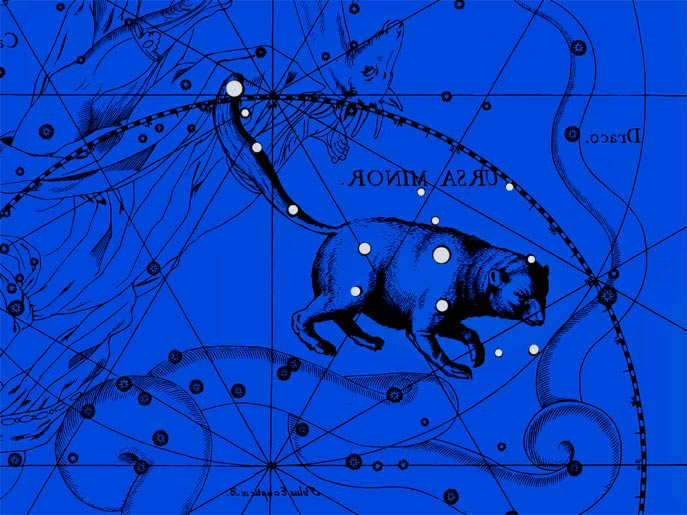There is perhaps no constellation in the northern hemisphere sky that is more well-known than the Little Bear. It is the one that children often inquire about and even attempt to spot in the night sky.
Why has it garnered such special attention, considering that the Little Dipper appears rather unassuming? Primarily because it is home to Polaris, the North Star. This star is of great importance for navigating and orienteering, so it is beneficial for everyone to know how to locate it. Therefore, it is crucial to show your children this constellation and Polaris – this knowledge can potentially save lives and is always useful.
But for now, let’s examine the Little Bear more closely from the perspective of an astronomy enthusiast.
The Small Bear in the Celestial Sphere
The Small Bear can be found in the polar region of the sky and can be seen throughout the year in the northern hemisphere. It is known as Ursa Minor, or UMi. The stars that make up this constellation are arranged in a formation that resembles a “bucket”, similar to the Big Dipper, but with a distinctively curved “handle”.
In the celestial sphere, the Small Bear is positioned in the northern direction. The final star in its tail is Polaris, which remains fixed in its position. The height of Polaris above the horizon, measured in degrees, is equal to the latitude of the observer’s location. As a result, Polaris not only indicates the way to the north, but also enables precise determination of one of the coordinates. The Phoenicians were the first to notice and utilize this characteristic, giving them a navigational advantage at sea for over a millennium.
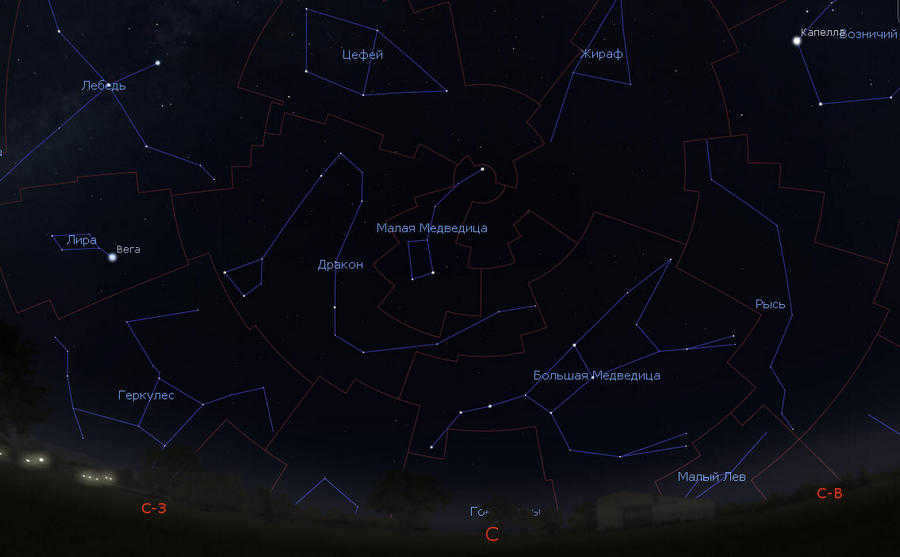

The position of the Little Bear constellation in the sky on January 1st.
The position of the other stars in the Little Bear constellation may change throughout the year or day, appearing to rotate counterclockwise around Polaris. Interestingly, this constellation is visible all year round in the northern hemisphere and can be seen on clear nights in Russia as it never dips below the horizon.
Adjacent to the Little Bear is a larger and more prominent constellation known as the Big Dipper. By drawing a line through the two outermost stars in its “bucket”, you can easily locate Polaris. This is a well-known and simple method that can be taught to children as well.
When it comes to size, the Little Bear ranks 56th among all constellations, covering a mere 256 square degrees in the celestial sphere.
The Mythology behind the Little Bear Constellation
There are numerous myths surrounding this constellation, each with its own unique tale. One such legend is associated with the birth of Zeus, the mighty and supreme god of Ancient Greece. Zeus’ father was Cronus, a god known for devouring his own children due to a prophecy that one of them would overthrow him. To protect Zeus, his mother Rhea took him to a sacred cave atop Mount Ida. It was there that the nymphs Melissa and Kinosura cared for him, with Kinosura becoming his nurse. As Zeus grew into a powerful deity, he transformed Melissa into the Big Dipper and Kinosura into the Little Dipper, immortalizing their bond in the stars.
This legend has different variations. For instance, one version tells that Zeus was nourished by a goat named Amalthea and two actual bears, which later transformed into constellations.
There is another tale linked to the constellation Ursa Minor. In the land of Arcadia, King Lycaon ruled, and he had a beautiful daughter named Callisto. Her beauty was so exquisite that even Hera, the wife of Zeus, became envious. Being immensely powerful, Hera transformed Callisto into a hideous bear.
One day, while hunting in the forest, Callisto’s son, Arkadus, nearly killed a bear that he encountered – his own mother. Thankfully, Zeus intervened just in time and diverted the arrow. Subsequently, Zeus placed Callisto in the sky as the Big Dipper and her beloved dog as the Little Dipper. Arkadus himself transformed into the constellation Volopassus – its principal star, Arcturus, signifies the “guardian of the bear”.
By the way, Hera had a good reason to be envious – Arcadus was the son of Zeus, who once pursued the beautiful Callisto and won her over.
Every culture has its own mythology surrounding the Big and Little Dippers. The first is easily spotted in the night sky, while the second has the unique characteristic of orbiting around Polaris. Interestingly, the Kazakhs believed that Polaris was a nail, and the constellation itself was a harness attached to it, worn around the neck of the Horse (Big Dipper). In India, the Little Dipper was seen as a monkey hanging from its tail, connected to the pole of the world.
Stars of the Ursa Minor
The asterism of the Ursa Minor constellation consists of seven stars:
- α – Polaris.
- δ – Yildun
- ε – Urodelus.
- ζ – Alifa al Farqadin.
- η – Anwar or Allaso
- β – Kohab
- γ – Ferkad
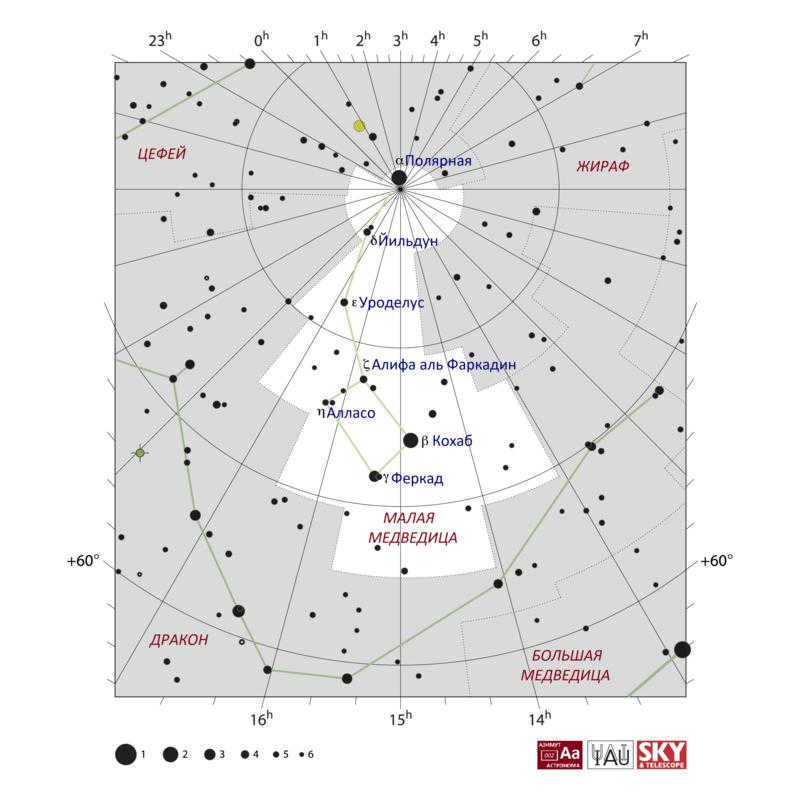
A visual representation of the constellation known as the Little Bear can be seen in the diagram above. The information for this diagram was sourced from Wikipedia.
Among the stars in this constellation, the outermost ones are referred to as the Guardians of the Pole, specifically Cohab and Ferkad. There are some intriguing stars within this constellation, and we will examine each of them in order.
Polaris: The Alpha Star of the Little Bear
Polaris may appear as an unremarkable small star in the night sky, with a brightness rating of 1.97 magnitudes. There are numerous stars similar to Polaris in terms of appearance, and without its proximity to the celestial pole, it would go unnoticed. However, upon closer inspection, Polaris has the ability to astonish.
The distance to Polaris is quite remarkable, approximately 447 light-years away, which means that humans would reach it in the not-so-distant future. If we were able to travel to Polaris, we would make an extraordinary discovery – it is actually a triple star system!
By using a telescope, we can observe the dual nature of the Polaris system from Earth. This system is centered around a supergiant that is 50 times bigger than our Sun, 6.5 times more massive, and emits light that is 2000 times brighter.
Located at a distance of 2400 astronomical units from this enormous star, there is a relatively ordinary star. It is only 1.39 times heavier than the Sun and can be seen from Earth, even with a small telescope, as a star with a brightness of 9m. It takes this star 100,000 years to complete a full orbit around the supergiant.
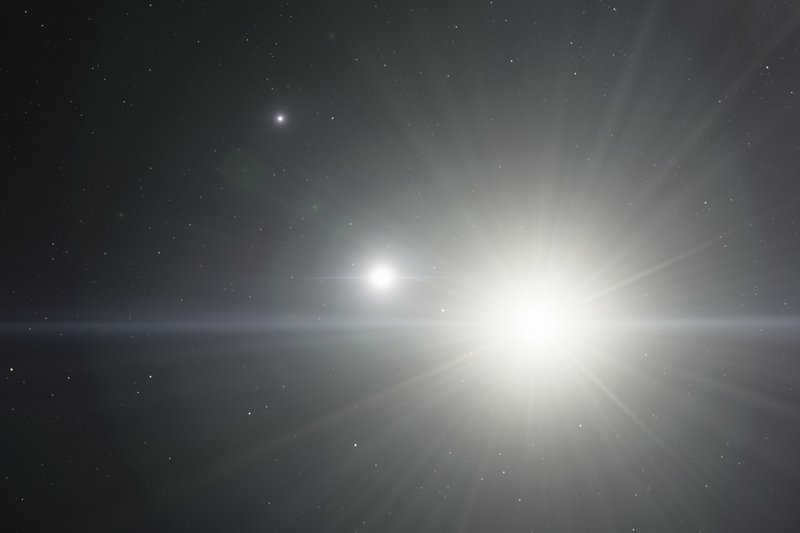
Discovered by William Herschel in 1779, this star has a yellowish-white color but appears greenish when observed through a telescope due to an optical illusion. Take a moment to admire this stunning celestial pair.
Located in close proximity to the central supergiant, the third component of this system is approximately 1.26 times the mass of the Sun and completes a full orbit every 30 years. It is identified as Polaris B.
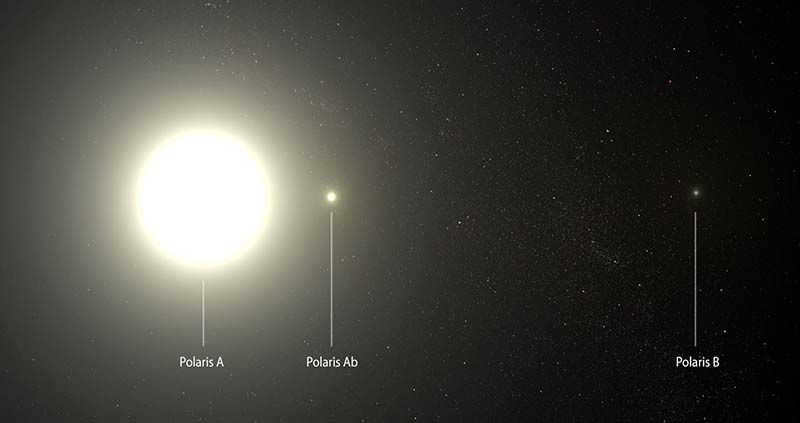
However, Polaris possesses an additional characteristic – it is a variable star of the delta Cephei type, specifically a Cepheid. Not only that, it happens to be the nearest known Cepheid to us. As a reminder, Cepheids are pulsating stars that exhibit periodic increases and decreases in brightness. Yet, Polaris stands out among Cepheids due to its fading pulsations. Just a century ago, its brightness exhibited much greater fluctuations compared to its current state, which has noticeably intensified.
Polaris is famous for its proximity to the North Pole. However, it has not always been the polar star, and in the future, it will no longer hold this position. Due to the Earth’s axis precession, different stars will take its place as the nearest to the pole. In the year 2102, Polaris will be the closest, but it will gradually move away. By 3200, Cepheus Gamma will become the new polar star, and by 13000, it will be Vega, the alpha star of Lyra. Interestingly, Vega was already a polar star in 13000 BC.
This is a youthful celestial body, with an age of merely 170 million years. It is radiating intense heat, with a surface temperature of 9900 K, thus classifying it as a white dwarf, despite having a radius 2.8 times greater than that of the Sun. Yildun, located at a distance of 172 light years, is much nearer to us than Polaris.
This celestial body is rotating at an extremely rapid pace, resulting in noticeable flattening at its poles. In approximately 700 million years, this celestial body will transform into a red giant – a fate that also awaits our Sun, albeit much further in the future. As Yildun draws closer to us, it will gradually intensify in brightness.
Urodelus serves as the epsilon in the constellation Ursa Minor.
This celestial body is actually a binary star system. At the heart of the system lies an orange giant, which is 19 times the size of our Sun and three times more massive. Despite its similar temperature, it emits 225 times more light than our Sun due to its significantly larger surface area.
The second star in this system has not been extensively studied. It is identified as a white main-sequence star that completes an orbit around the orange giant every 39.5 days. This close proximity between the two stars leads to periodic variations in brightness as the smaller star periodically eclipses the larger one. As a result, Urodelus is classified as an Algol-type variable star.
The distance to this binary star system is approximately 300 light-years, and it is gradually moving closer to us at a rate of 10.5 km per second.
Alifa, the zeta star of the Little Dipper
Alifa is a hot white star in the Little Dipper constellation, with a surface temperature of approximately 9000 K. It is larger than our Sun, being six times its size, and emits 191 times more light. Alifa is located at a distance of 337 light years from Earth, which makes it appear as a faint star with a brightness of only 4.2m in our sky.
Allaso is one of the stars in the Little Bear constellation
This particular star is also known by its popular name – Anwar al Farkadin. When observed in the night sky, it appears as an ordinary star with a brightness of 4.95m. Allaso is located at a distance of 96 light years from our planet.
Upon closer examination, it becomes evident that Allaso is actually a binary star system. The primary star in this system is a white-yellow dwarf, which is nearly twice the size of the Sun and 1.66 times more massive. Additionally, it is slightly hotter than our Sun. This is what we observe when looking at Allaso in the night sky.
The second component of this binary system is not well understood. It is classified as a red dwarf and is located 13 light years away from the main star. Although this distance may seem significant, gravitational interactions are still possible between these two stars.
The orange giant in the constellation is the second brightest star, measuring 42 times the size of the Sun and 2.5 times its weight. Kohab emits 400 times more light than our Sun – if it were positioned at the heart of our solar system, its immense radiation would scorch everything in sight.
Kohab possesses a yellow-orange satellite with a brightness of 11.3, which can be observed at an angular distance of 3.4 seconds.
In 2014, astronomers discovered an exoplanet in Kohab that is 6 times more massive than Jupiter. This planet orbits at a maximum distance of only 1.4 astronomical units from the star and completes a full revolution in just 522 days. Given the size and strength of the star, this planet can be classified as a hot Jupiter.
Ferkad is the brightest star in the constellation Ursa Minor
This celestial body is quite ordinary – it is a white giant star, with a size 15 times bigger than the Sun and a mass 8 times greater. Ferkad radiates 1100 times more light than our Sun, making it appear as bright as a +3m star in the night sky, despite its considerable distance from us of approximately 480 light years.
Ferkad belongs to the category of variable stars known as Delta Scuti, meaning it undergoes fluctuations in brightness by 0.05m every 3.43 hours. These fluctuations are caused by pulsations occurring on the surface of the star.
Galaxies in the Little Bear constellation
When it comes to amateur observations, the Little Bear constellation offers very few sights. In fact, there is only one galaxy present, and it happens to be a dwarf elliptical galaxy, hence its name – the Little Bear.
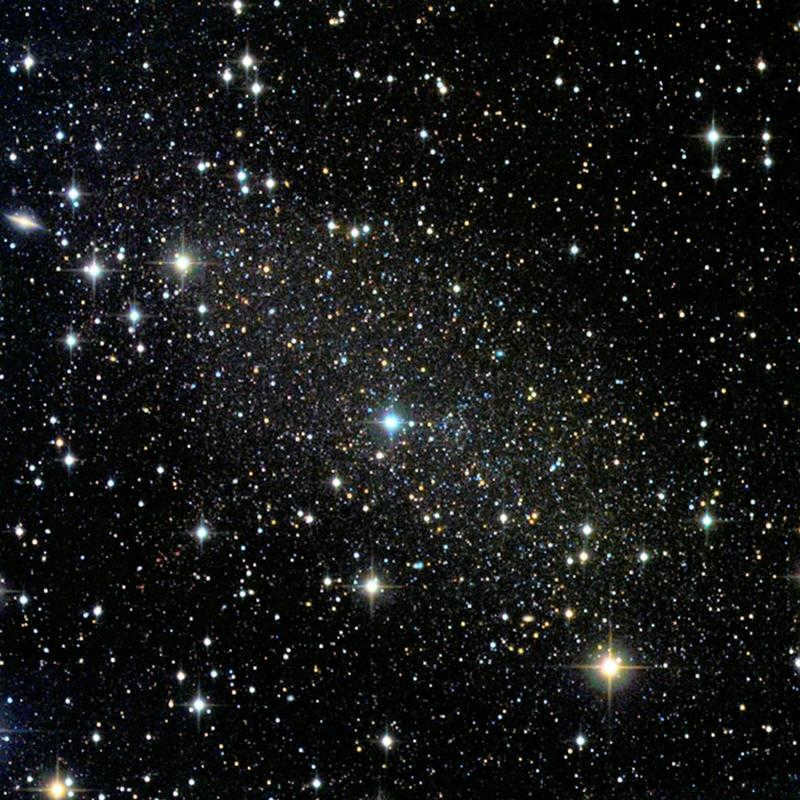
The galaxy known as the Little Dipper.
This particular galaxy is composed of ancient stars, with star formation occurring a staggering 14 billion years ago and lasting for a period of 2 billion years. Following this, the appearance of new stars has been quite scarce.
The Little Bear Galaxy functions as a satellite of our Milky Way, similar to the Magellanic Clouds.
The constellation contains a meteor shower called the Ursids, which occurs annually from December 17th and lasts for approximately one week. The peak of the shower is on December 22nd, during which you can witness around 10 meteors per hour. However, there have been instances where the activity of the Ursids significantly intensified, like in 1945 when it produced an impressive 120 meteors per hour.
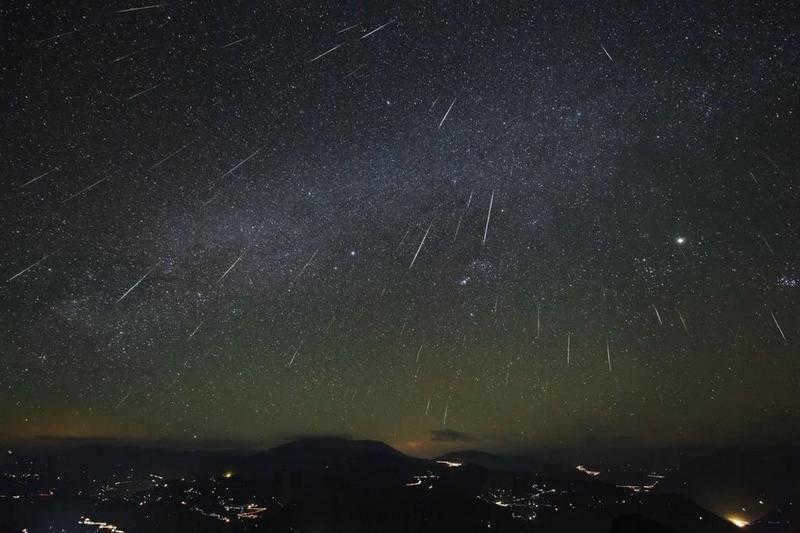
The Ursid meteor shower is caused by the comet Tuttle, which was initially observed by Pierre Mechene in 1790. This comet completes a full orbit around the sun in approximately 14 years.
The constellation Ursa Minor, also known as the Little Bear, is a permanent fixture in the night sky. While it may not have many prominent features, it is still worth locating and observing its stars. Don’t forget to point out Polaris to your children!
Ursa Minor is a constellation located in the northern hemisphere, and its name translates to “lesser bear” in Latin.
The Little Bear constellation first appeared in the night sky during the second century, thanks to the observations made by Ptolemy. It can be easily identified by its well-known asterism or its position near the north celestial pole. Polaris, also known as the North Star, can be found at the end of the handle of the Big Dipper.
Despite being documented by Ptolemy, it is attributed to Thales of Miletus (who lived from 625 to 545 BC). Thales was recognized as one of the seven wise men of ancient Greece. However, there is an alternative theory that suggests he merely introduced it to the Greeks after learning about it from the Phoenicians, who were already using the constellation for navigation. In fact, the Greeks initially referred to it as the Phoenician constellation until it eventually became known as the Little Bear (previously referred to as the Tail of the Dog).
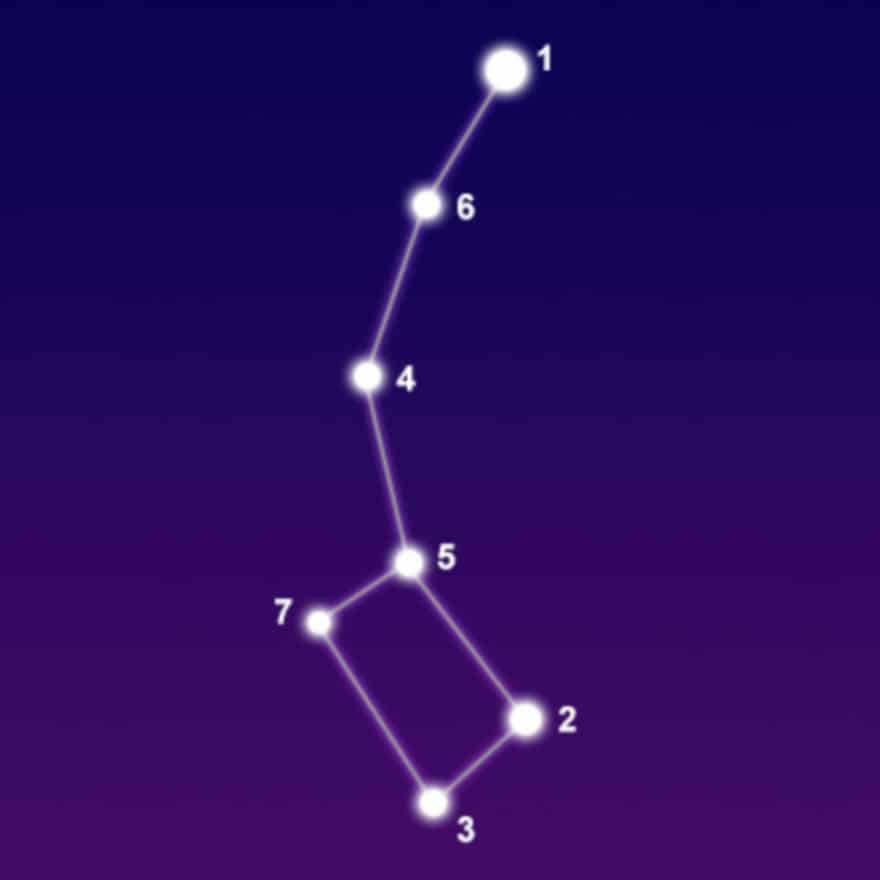
Facts, Position, and Map
Spanning an area of 256 square degrees, the Little Bear constellation holds the 56th position in terms of size. It occupies the third quadrant in the northern hemisphere (NQ3) and can be observed at latitudes ranging from +90° to -10°. Its neighboring constellations include Chameleon, Cepheus, and Dragon.
Within this constellation, there is a star accompanied by a planet, but no Messier objects. The brightest star in the Little Bear constellation is Polaris (Alpha Minor Bear), which has an apparent visual magnitude of 1.97. Additionally, there is a meteor stream known as the Ursids. The Little Bear constellation is part of the Big Dipper group, which also includes Veronica’s Hair, Giraffe, Dragon, Lesser Lion, Big Dipper, Lynx, Northern Crown, Hound Dogs, and Wolfsbane. Take a look at the star map to examine the diagram of the Little Bear constellation.
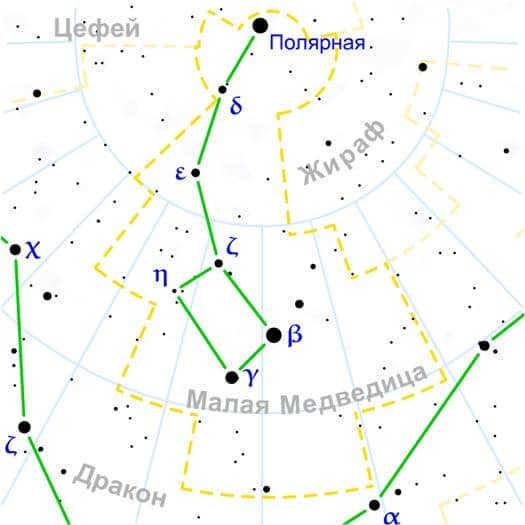
Legend
There are two distinct legends surrounding the Little Bear. The first one revolves around Ida, a nymph who nurtured Zeus during his childhood on the island of Crete. Rhea, Zeus’ mother, had to conceal him from his father, Cronus, who was known for killing all of his offspring due to a prophetic warning. Upon Zeus’ birth, Rhea substituted a stone in his crib, deceiving her husband. The prophecy eventually came to pass, as Zeus overthrew his father and liberated his brothers and sisters, who went on to become the Olympian deities.
There is another tale about Arcas. He happens to be the offspring of Zeus and Callisto, who is a nymph. Callisto was devoted to Artemis and had no interest in associating with men. However, she couldn’t resist the charms of Zeus. When Hera discovered the betrayal, she was furious and transformed Callisto into a bear. For 15 years, Callisto roamed the forest until she came across the grown-up Arkas. Frightened, he drew his spear. But Zeus intervened just in time and summoned a whirlwind that whisked them both up to the heavens. Callisto became the constellation Ursa Major, also known as the Big Dipper, while Arkas became Ursa Minor, the Little Dipper. Although, more often than not, this legend is associated with Volopassus.
There is an even older myth that suggests the 7 stars represent the Hesperides, the daughters of Atlas, who were responsible for guarding the apples in Hera’s garden.
The Little Dipper is formed by the stars Polaris, Yildun, Epsilon, Eta, Zeta, Gamma, and Beta.
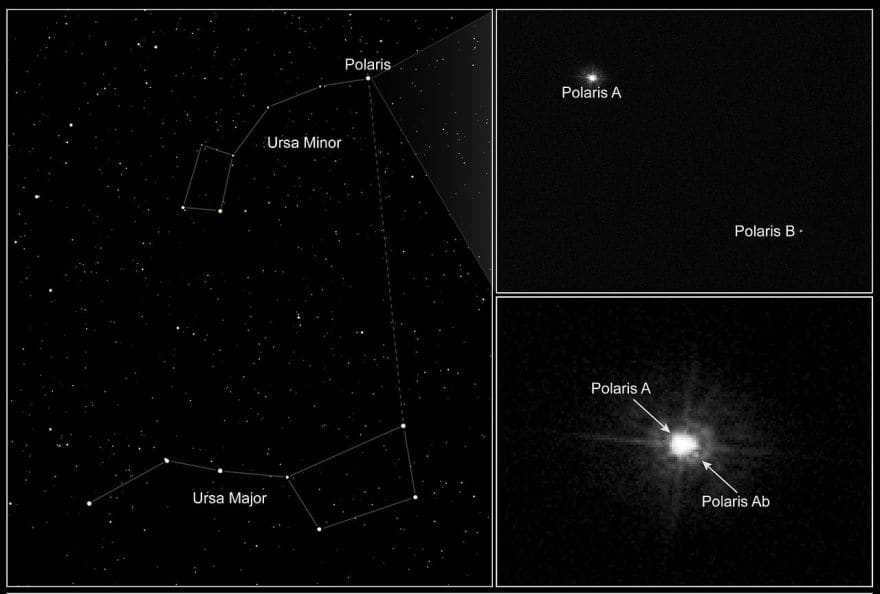
Polaris is a trinary star system.
Notable stars
Take a closer look at the prominent stars in the constellation Little Bear in the northern hemisphere. You will find detailed descriptions, photos, and characterizations.
Polaris, also known as Alpha of the Little Bear, is a multiple star system (F7:Ib-II) with an apparent magnitude of 1.985 and located approximately 434 light-years away. It has been the closest bright star to the north celestial pole since the Middle Ages and is the brightest star in the Little Bear constellation.
To locate Polaris, you need to follow Dubhe and Merak, the two brightest stars at the end of the Big Dipper asterism.
Polaris is composed of a bright primary star (A), two smaller companion stars (B and Ab), and two distant stars (C and D).
The most luminous celestial object is a massive (II) or supergiant (Ib) with F8 spectral class. Its mass is six times that of the sun. In 1780, William Herschel discovered that B is a star in the main sequence with F3 spectral class, and Ab is a dwarf star in a very close orbit.
Polaris is a variable star in the Cepheus constellation. In 1911, Einar Hertzsprung, an astronomer from Denmark, confirmed its variability. During Ptolemy’s observations, it had a magnitude of 3, but today it has a magnitude of 2. Due to its brightness and proximity to the celestial pole, it plays a crucial role in astronomical navigation.
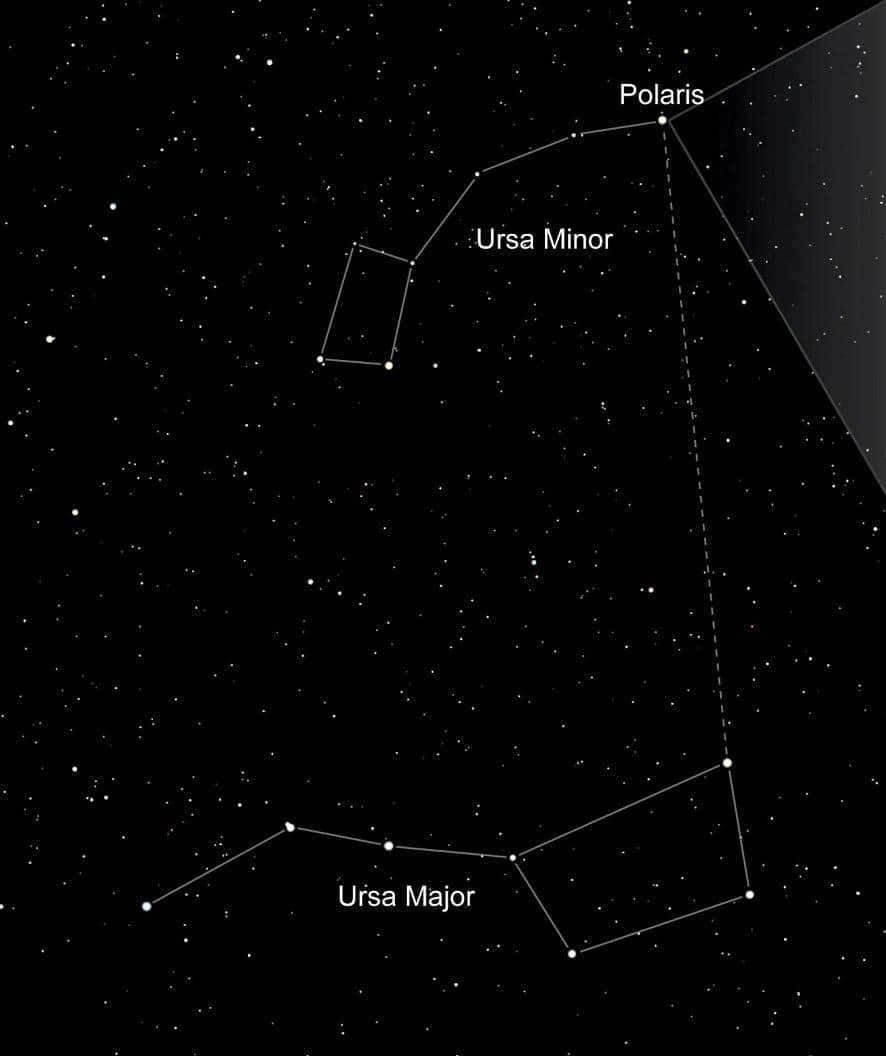
The constellation Ursa Minor contains the stars known as the Big Dipper and the Little Dipper.
Cohab, which is the Beta star of Ursa Minor, is a giant star (K4 III) with a visual magnitude of 2.08, making it the brightest star in the Little Dipper’s bowl. It is located at a distance of 130.9 light-years from Earth. Beta and Gamma stars are sometimes referred to as the Guardians of the Pole because they appear to orbit around Polaris, the North Star.
From 1500 BC to 500 AD, Cohab and Gamma were considered twin stars as they were the nearest bright stars to the north celestial pole. Cohab is 130 times brighter than the Sun and 2.2 times more massive.
The traditional name “Cohab” is derived from the Arabic word “al-kawkab,” which means “star.” It is actually an abbreviation of “al-kawkab al-šamāliyy,” which translates to “north star.”
Ferkad, also known as Gamma of the Little Bear, is a type A star with a visible brightness of 3.05 and is located approximately 487 light-years away. It falls under the A3 lab classification and has a rotational velocity of 180 km/s. In terms of size, Ferkad is 15 times larger than our own sun and shines 1,100 times brighter.
What sets Ferkad apart is its unique feature as an envelope star, which means it possesses a gas disk surrounding its equator. This results in fluctuations in the star’s brightness.
The name Ferkad comes from the Arabic word for “calf”.
Yildun, also known as Delta of the Little Bear, is a white dwarf star in the main sequence. It belongs to the A1V spectral class and has a visual brightness of 4.35. Yildun is located approximately 183 light-years away. The traditional name Yildun translates to “star” in Turkish.
Zeta of the Ursa Minor constellation is classified as a main-sequence dwarf star (A3Vn) with a visual magnitude of 4.32 and is located approximately 380 light-years away. It is currently in the process of transitioning into a giant star, with a mass 3.4 times that of the Sun and a brightness 200 times greater. The surface temperature of Zeta is measured at 8700 K. Additionally, it is suspected to be a variable star of the Delta Shield type.
The name “Zeta” is derived from the Arabic term “aḫfa al-farqadayn,” which translates to “leading two calves.”
Another star in the Ursa Minor constellation, commonly referred to as the Little Bear, is a yellow-white main-sequence dwarf star (F5 V) with a visual magnitude of 4.95 and a distance of 97.3 light-years. This star can be easily spotted without the need for any advanced technology.
In Arabic, this star’s name translates to “brighter than two calves.”
Epsilon, another star within the Ursa Minor constellation, is a triple star system located 347 light-years away. It consists of two main components: A, a yellow giant star of the G-type (which is an eclipsed spectroscopic double star), and B, an 11th magnitude star located at an angular distance of 77 seconds.
Epsilon A is classified as an RS Hound Dog type variable. The brightness of this binary system fluctuates as one object periodically eclipses the other. The overall brightness ranges from 4.19 to 4.23 with a period of 39.48 days.
Celestial Objects
The Little Dipper (PGC 54074, UGC 9749) is a dwarf elliptical galaxy with an apparent magnitude of 11.9 and a distance of 200,000 light-years. It is a satellite galaxy of the Milky Way. The majority of its stars are elderly, and there is minimal visible star formation.
Its discovery took place in 1954. Data gathered by the Hubble Space Telescope in 1999 confirmed that the galaxy underwent a formation process 11 billion years ago, which lasted for 2 billion years.
If you want to explore the constellation Ursa Minor in the northern hemisphere in more detail, you can rely on not only our photographs but also 3D models and an online telescope. To aid in your search, a star map will be useful.
The constellation Ursa Minor is also known as the Little Bear with the long tail.
The brightest star in this constellation indicates the position of the north celestial pole, which is why it is also called Polaris.
Due to its shape, Ursa Minor was previously referred to as Cynosure and Dog’s Tail before being named Little Bear. The seven brightest stars in the constellation Ursa Minor form an asterism, which is a recognized star pattern that does not constitute a complete constellation.
Where to Find the Little Bear
The Little Bear can be found in the sky of the northern hemisphere.
With a surface area of 256 square degrees, the Little Bear ranks as the 56th largest constellation. It is positioned in the third quadrant or NQ3, spanning latitudes +90 degrees to -10 degrees. As a circumpolar constellation, it remains above the horizon and can be observed in the northern sky all year long.
Adjacent constellations to the Little Bear include the Dragon, Cepheus, and Camelopardalis.
Stars of Ursa Minor
The constellation Ursa Minor is known for its seven prominent stars: Polaris (Alpha Ursa Minoris), Cohab (Beta Ursa Minoris), Ferkad (Gamma Ursa Minoris), Yildun (Delta Ursa Minoris), Urodelus (Epsilon Ursa Minoris), Anwar al Farkadain (Eta Ursa Minoris), and Ahfa al Farkadain (Zeta Ursa Minoris).
Polaris, also known as the North Pole Star or North Star, is the brightest star in the Little Bear constellation. Positioned closest to the north celestial pole, it serves as a navigational guide due to its brightness and proximity to the North Pole. Polaris is also referred to as Alpha of the Little Bear and is part of a triple star system. The primary star, Polaris Aa, is a giant yellow star located 434 light years away from our solar system. Initially observed as a third magnitude star, it has since become brighter and is now classified as a second magnitude star. Sailors in particular rely on Polaris for accurate navigation, some even considering it more reliable than a compass when determining northward direction.
Ferkad, also known as Gamma of Ursa Minor, is a massive white star located 487 light-years away from our planet. This particular star is surrounded by a disk composed of gas. The presence of this gas can be attributed to the star’s rapid rotation, which causes changes in its brightness and earns it the title of a shell star. Ferkad, along with Kochab, is often referred to as the Guardians of the Poles due to their apparent orbit around Polaris.
Yildun, or Delta of Ursa Minor, is a white star situated 172 light-years away from our Sun. This star, which belongs to the Little Dipper constellation, is characterized by its high rotational speed, resulting in a flattened shape. Yildun shines with a brightness that is 47.7 times greater than that of our Sun.
Urodelus, also known as Epsilon in the constellation of Ursa Minor, is a binary star situated 347 light years away from our planet. Anwar al Farqadain, or This Little Dipper, is a yellow main-sequence star positioned 97 light-years from Earth. Ahfa al Farqadain, or Zeta of the Little Dipper, is a main-sequence dwarf star located 380 light years away. This star shines with a brightness 227 times greater than that of our Sun.
H1504+65, a peculiar and exceptional star within this constellation, holds a record as the hottest white dwarf ever observed. With a surface temperature of approximately 200,000 K, it resides at a staggering distance of 1,590 light-years from our planet.
Deep space objects in the constellation Ursa Minor
The Ursa Minor constellation is home to various deep space objects. These include the Ursa Minor dwarf galaxy, the NGC 3172 galaxy, and the Ursid meteors.
The Ursa Minor dwarf galaxy has a spherical shape and is primarily made up of ancient stars. It is situated approximately 225,000 light years away from Earth. This dwarf galaxy is a satellite of the Milky Way and was initially detected in 1954 by A. G. Wilson at the Lowell Observatory.
The NGC 3172 galaxy, also known as Polarissima Borealis, is the nearest galaxy to the northern celestial pole. Located 67 million light-years from Earth, it is classified as a starburst galaxy due to its high rate of star formation. NGC 6251 serves as an example of a Seyfert galaxy, which is a specific type of spiral galaxy.
Ursids are meteor showers that occur within the constellation of Ursa Minor.
Legends connected with Ursa Minor
There are numerous legends linked to this constellation, but the most well-known one originates from Greek mythology. It was prophesied that the god Cronus would be overthrown by one of his own children. Cronus, fearing this fate, swallowed his five offspring as soon as they were born. However, his wife Rhea wanted to save her sixth child and deceived Cronus by giving him a stone to swallow instead. She then entrusted the baby Zeus to Ida and her sister Adrasteia, two nymphs, who raised him. Zeus grew into adulthood and fulfilled the prophecy by slaying his father Cronus. In gratitude for their care, Zeus immortalized the nurses by placing them among the stars. Ida became Ursa Minor, and her sister Adrasteia became the Big Dipper.
There is another tale that the seven stars of the Little Dipper represent the seven daughters of Atlas, who are known as the Hesperides. These sisters were responsible for tending to Hera’s garden, which contained a tree that bore apples with the power of immortality.
Another Greek legend regarding the formation of this constellation is also connected to Zeus and shares the same story that explains the origin of the Big Dipper, a nearby constellation. Zeus, the ruler of the gods, fell in love with a nymph named Calisto. His wife became enraged and envious, transforming Calisto into a bear. To shield his beloved and their child Arkas from his wife’s wrath and jealousy, Zeus cast them into the heavens, giving rise to the constellations of the Big Dipper and Little Dipper. The elongated tails of these constellations are a result of Zeus lifting the bears by their tails.
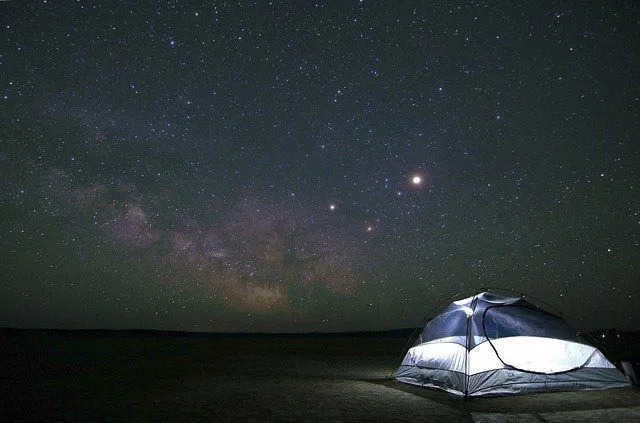
Frequently Asked Questions
How can I locate the Little Bear?
To find the Little Bear, the best approach is to face directly north and locate the brightest star in the northern sky. This star is known as the North Pole star or polar star and forms part of the Little Bear constellation. It can be found at the top of the handle of the Big Dipper. Another method is to search for two prominent stars, Dubhe and Merak, which are also part of the Big Dipper. These stars can help guide you towards Polaris or the North Star.
When can the Little Bear be seen?
This constellation is visible at 9 PM in June, between latitudes +90° and -10° in the northern hemisphere.
How did the Little Bear obtain its name?
When was the Little Bear discovered?
The Little Bear was initially recorded by the Greek astronomer Ptolemy in the 2nd century.
What is the Little Dipper?
The Little Dipper is a configuration of stars within the constellation of the Little Bear.
What is the brightest star in the Little Dipper?
Polaris holds the distinction of being the brightest star in the Little Bear constellation.
Who discovered the Little Bear?
The Little Bear was first cataloged by the Greek mathematician and astronomer Charles Ptolemy in the 2nd century.
What are the other two names for the Little Bear?
The Little Bear and the little bear are two alternative designations for the Little Bear.
What is special about the Little Bear?
The Little Bear constellation is unique because it holds the Little Bear asterism, which is utilized in navigation to locate the north celestial pole.
What is the official name for the Pleiades star cluster?
The Pleiades, situated in the Taurus constellation, is a collection of over 800 stars that are positioned 410 light-years away from Earth. It is also known as the Seven Sisters or M45.
Is it possible to observe the Little Bear in the southern hemisphere?
Unfortunately, individuals in the southern hemisphere are unable to see this constellation.
Can the Little Bear be observed in Australia?
Given that Australia is found in the southern hemisphere, the Little Bear cannot be seen. This constellation is only visible in the northern hemisphere.
Which constellation remains visible throughout the entire year?
The constellations that can be seen all year round, including the Big Dipper and Little Dipper, are visible on clear nights.
Authored by.
The Kidadl team is composed of individuals from various walks of life, families, and backgrounds, each with their own unique experiences and nuggets of wisdom to share. Their hobbies and interests span a wide range, from linoleum cutting to surfing to children’s mental health. They are dedicated to transforming ordinary moments into cherished memories and providing you with inspiring ideas for family fun.
Gazing at the stars in the dark night sky is arguably one of the most soothing activities to do after a long day.
The vastness and boundlessness of the celestial sky and brilliantly gleaming celestial bodies have perpetually captivated individuals. Numerous celestial bodies are acknowledged as constituents of diverse constellations, instigating individuals to continuously search for new constellations to identify distinct celestial bodies.
In order to locate the constellation of the Little Dipper within the Little Dipper itself, one must initially locate the Big Dipper. The Big Dipper encompasses a handle composed of three celestial bodies and a bowl comprised of four celestial bodies. Dubhe and Merak are two luminous celestial bodies that point towards Polaris and the Little Dipper, thus earning the moniker of “pointer stars”. The Little Dipper is situated in the upper right quadrant of the Big Dipper.
Continue reading to gain further insight regarding the Big Dipper, the Little Dipper, and other significant constellations adorning the nocturnal sky.
Alternative Titles for the Little Bear Constellation
A constellation is a group of stars that have been given a specific name and form in the sky, resembling a particular shape. These stars are situated far away from our planet and are not identical to one another. Some stars within a constellation are close together, while others are more distant. Nonetheless, if you use your imagination and connect the stars with lines in the sky, like a jigsaw puzzle, the resulting image will resemble an object, animal, or person.
Throughout history, various cultures around the world have assigned different names and designations to constellations based on what they perceived. Currently, there are officially recognized 88 constellations.
The Little Dipper has served as a guide for sailors for many years. This group of stars was first identified in 600 BC by Thales of Miletus. It was formed from the remains of an earlier constellation called Draco, which represented a mythical dragon. Before it became known as the Little Dipper, it was referred to as the Dog Tailor of Cynosure.
Throughout history, this constellation has been given various names, including the Big Dipper, Van, Charles Wayne, and Plow, among others.
Position of the Little Bear galaxy
The Little Dipper is part of the Big Dipper constellation, which is the 56th largest constellation in the sky. It can be seen between +90° and -10° and is located in the Northern Hemisphere’s third quadrant (NQ3). The stars in the Little Bear vary in brightness from the second to fifth magnitude, making it challenging to identify on nights with poor visibility.
Despite being several degrees away from the celestial pole, Alpha of the Little Bear has served as Polaris since medieval times. It is the brightest star among seven other prominent stars in our solar system. These seven stars are the most luminous in the entire solar system.
Polaris, which is also referred to as the North Star, is a celestial body that is situated almost directly above the North Celestial Pole and serves as a reliable indicator of the true north. Due to its brightness and prominent location in the constellation Ursa Minor, Polaris is widely recognized as a valuable navigational tool. Space is adorned with numerous star formations, including the bucket-shaped asterism that comprises seven prominent stars and forms the handle of the Big Dipper. Notably, Polaris stands as a prominent star in the Northern Hemisphere.
The best time to observe the Big Dipper and the Little Dipper constellations is at 9:00 p.m. in June. However, it is necessary to have a clear sky without any pollution. In instances where the sky is hazy and dark, and the Little Dipper is not visible, Polaris can still be found by looking at the stars in the Big Dipper. The Little Dipper is also known as the Little Bear and is located in the northern sky. Its tail, which resembles the handle of a dipper, gives it the name Little Dipper in North America. The Little Dipper consists of seven stars in its bowl, while its friend, the Big Dipper, has four stars in its bowl. It was one of Ptolemy’s 48 constellations in the second century and is now one of more than 80 modern constellations.
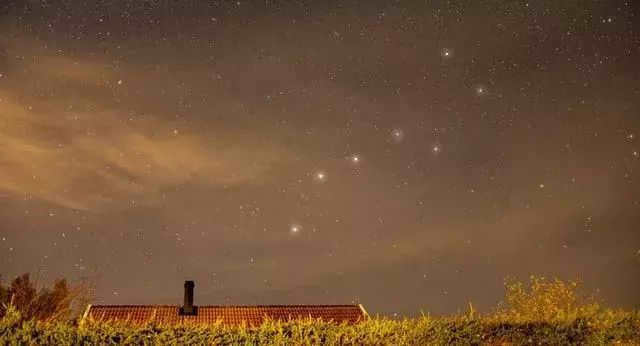
The Little Dipper constellations are situated along the border
Due to its position as the North Pole star, the Little Bear constellation has historically been utilized for navigation, particularly by sailors. It is also commonly referred to as Polaris. Polaris is recognized for its ability to assist travelers in finding their way by indicating the direction towards the North Pole. Its discovery is credited to the ancient Greek astronomers and seafarers.
Within the vicinity of the Little Dipper, there are three surrounding constellations known as Camel, Cepheus, and Dragon.
Characteristics of the Little Bear’s Shape
Astronomers refer to the constellation of the Little Bear as the Little Bear. The tail of the Little Bear resembles the handle of a dipper, similar to that of the Big Bear. This is why it is called the Little Bear in North America: it has seven stars in its bowl and four in the bowl of its companion, the Big Dipper.
The representation of the Little Dipper is primarily focused on the constellation of the Little Dipper. The ladle’s bowl represents the side of the Bear, while the handle represents its tail. The ladle’s handle stars, Polaris, Yildun, and Urodelus, are referred to as the “handle of the ladle.” The other four stars, Kohab, Ferkad, Anwar al-Farkadain, and Ahfa al-Farkadain, are known as the “bowl” or “body.” The celestial tail of the Little Bear is formed by the handle of the Little Bear constellation. Conversely, the bowl is a part of the Little Bear constellation.
The Little Bear asterism is made up of seven stars, including:
Polaris is a multi-star system consisting of one primary star, two minor companion stars, and two outer stars. The primary star, known as the yellow supergiant F7, is the main component of the system. It has a mass approximately 4.5 times that of the Sun. Accompanying the primary star are two main-sequence stars classified as F3 and F6.
Polaris, also referred to as Polaris, is a star that is positioned almost directly above the North Celestial Pole and serves as a reliable navigational aid, pointing towards the true north direction.
Yildun, which is situated 183 light-years away from Earth, is a main-sequence white dwarf categorized as A1V in terms of spectral class. It possesses a magnitude of 4.35.
Beta of the Little Bear is a massive star located approximately 131 light-years away from the solar system. The star’s visual magnitude is estimated to be 2.08. It stands out as the most brilliant star in the Little Bear constellation.
© 2022 by Kidadle LLC. All rights reserved.
“After mastering the ability to locate the Big Dipper and Polaris, the Little Bear constellation is the next constellation to explore in order to further your understanding of the night sky. Familiarizing yourself with the stars will always be helpful for navigating the terrain.”
"Currently, astronomy is an elective subject in schools and not a mandatory one."
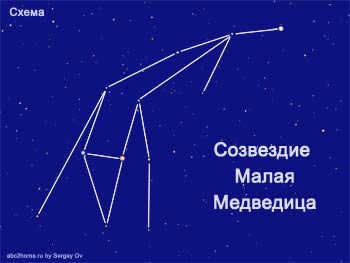
Figure 1: Scheme of the Little Dipper constellation
The constellation Ursa Minor, although ranked 27th among the constellations of the Northern Hemisphere and 56th in terms of angular area among all the constellations of the celestial sphere, holds great navigational significance as it currently houses the North Pole.
It is important to note that Ursa Minor is part of a constellation group with its older sister, the Big Dipper [1].
Ursa Minor is bordered by only three constellations – Draco, Camelopardalis, and Cepheus.
Being the northernmost constellation, Ursa Minor never sets below the horizon in Russia and all countries located north of the Tropic of Cancer.
Stars and outline diagram of the constellation of Ursa Minor
The Ursa Minor constellation does not possess a large number of brilliant stars. The luminous “collection” encompasses just three stars – the most radiant one being Alpha Ursa Minoris, commonly known as Polaris (α UMi, 1.97), the second most brilliant star is Beta Ursa Minoris, also known as Cohab (β UMi, 2.07), and the third one is Gamma Ursa Minoris, referred to as Thercade (γ UMi, 3.00). All other stars that are visible without any visual aids are categorized as fifth and sixth magnitude stars. A distinctive feature of the Little Dipper is that each and every star, even the faint ones that constitute the asterism [2] Small Bucket, has its own individual designation (Fig. 2).
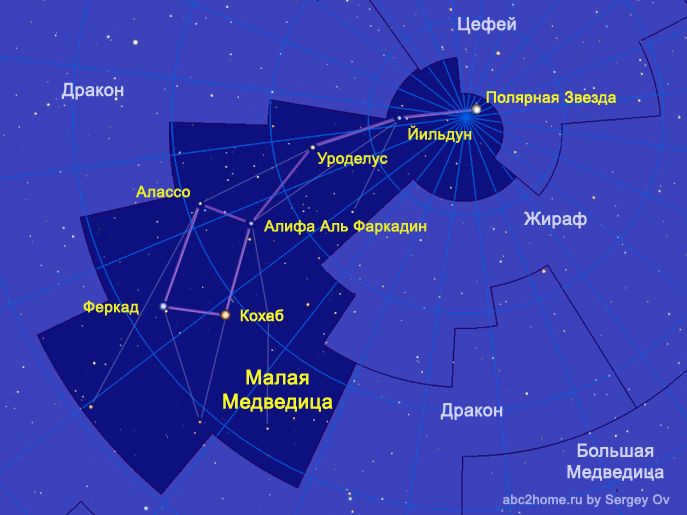
Constellation of Ursa Major, stars of Ursa Major constellation
Sergey Ov
Fig. 2 Constellation of Ursa Minor. Names of the brightest stars. Lilac line – asterism “Little Dipper” as a symbol of the Little Dipper
As shown, Figure 2 names four more stars of the 5th magnitude: Urodelus (ε UMi), Alifa Al Farkadin (ζ UMi), Yildun (δ UMi), and Alasso (η UMi).
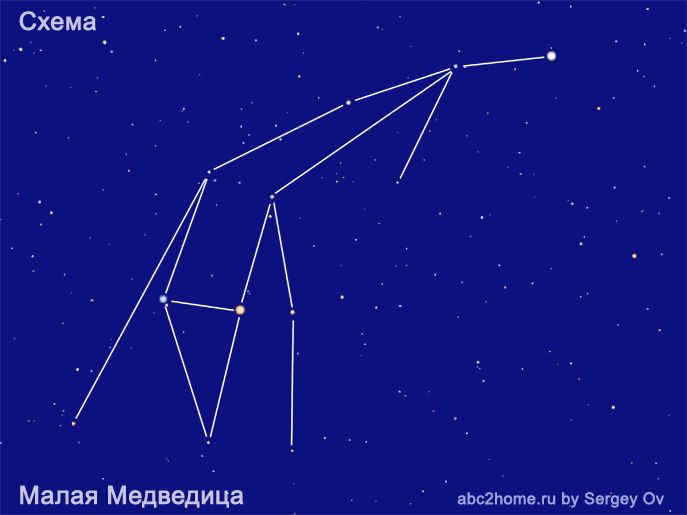
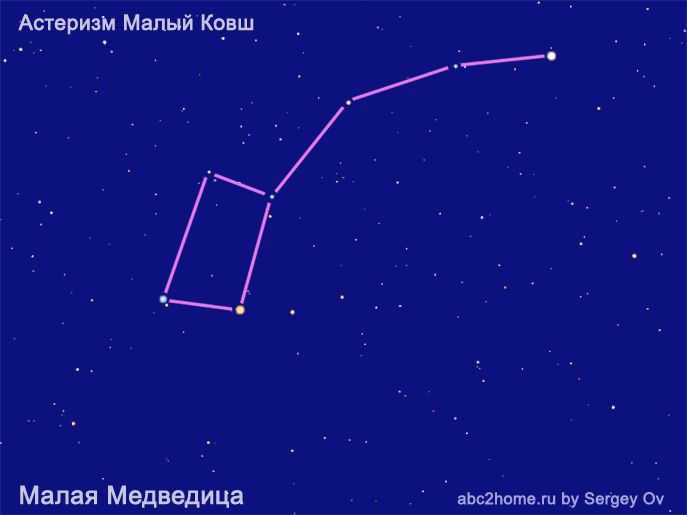
The Little Bear constellation consists of stars that form the shape of a beast following a trail. The diagram of the constellation, shown in Figure 3, depicts the contour image of the stars. The stars that make up the contour of the diagram are Polaris (α UMi), Yildun (δ UMi), Urodelus (ε UMi), Alasso (η UMi), RR of the Little Bear (RR UMi), Fercad (γ UMi), HD 124730 (HIP 69373), Kohab (β UMi), Alifa Al Farqadin (ζ UMi), 5 Little Bear (5 UMi), HD 118904 (or alternatively, 4 Little Bear – 5 UMi), Alifa Al Farqadin (ζ UMi), Yildun (δ UMi), and HD 133002 (HIP 72573).
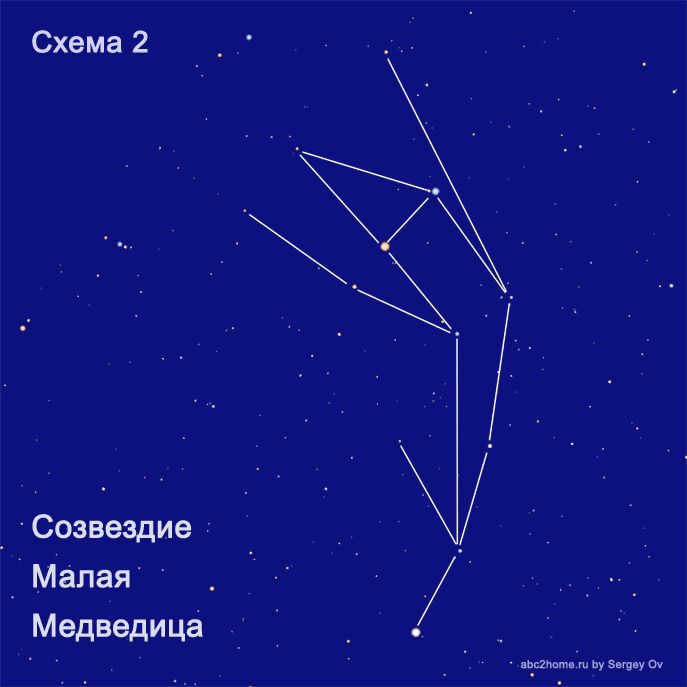
Polaris: A Star Elevated Temporarily
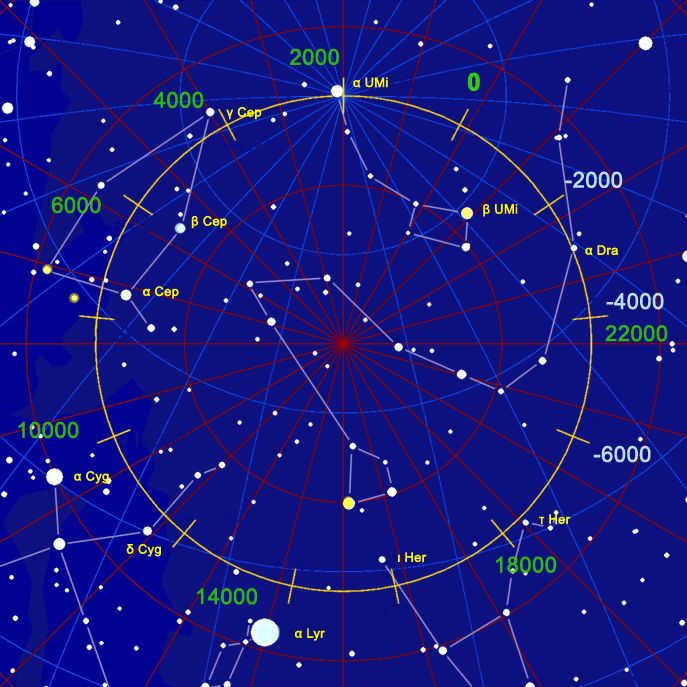
Discovering the constellation of Ursa Minor and Polaris: a step-by-step guide
To locate the Little Bear constellation, you can begin by locating Polaris. The configuration of the constellation is so simple that finding Polaris essentially means finding the Little Bear. There are two ways to find Polaris. 1. The most common method is to use the Big Bucket asterism in the Big Dipper constellation. To find Polaris, mentally draw a line between the stars on the edge of the Bucket from Merak to Dubhe, and continue to the first bright star – this will be Polaris, indicating the direction to the North! You can verify this by mentally drawing a Small Bucket pouring water into the Big Bucket (Fig. 6). Polaris is the most important navigational star, and Merak and Dubhe, which help locate it, are also known as Pointers. 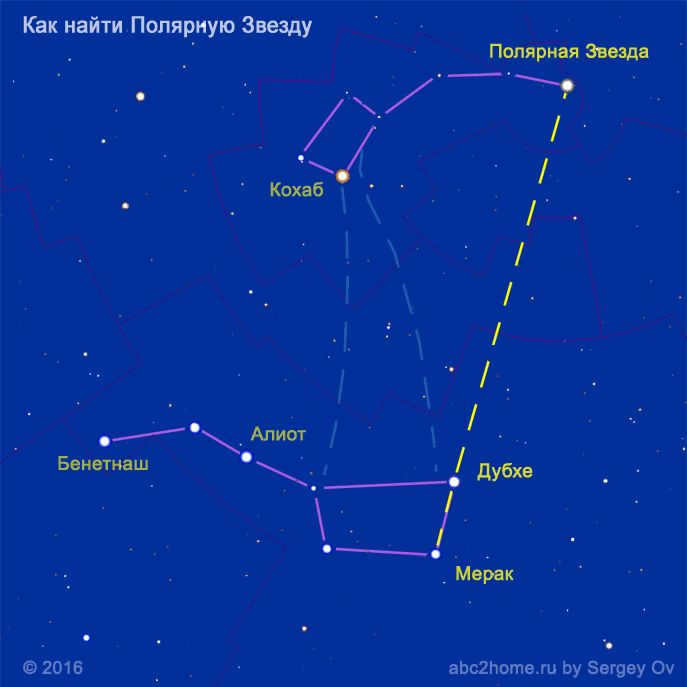 Fig. 6 Finding Polaris is very simple! Just mentally draw a line through the stars of the Big Bucket, Merak, and Dubhe. 2. Another method is to use a compass, knowing that Polaris is exactly in the north. Determine the latitude of your location to the nearest degree (for example, the latitude of Moscow is approximately 56°) – Polaris will rise at this angle. On a starry night, face the direction of the North with the help of a compass, and using outstretched hands (Fig. 7), measure the height from the horizon, slightly underestimating the angle of the Polar Star. (The angular distance between the thumb and index finger of an adult’s outstretched hand is 16-18°). The nearest brightest star above your hands will be Polaris. (There are no bright stars within 15° around Polaris).
Fig. 6 Finding Polaris is very simple! Just mentally draw a line through the stars of the Big Bucket, Merak, and Dubhe. 2. Another method is to use a compass, knowing that Polaris is exactly in the north. Determine the latitude of your location to the nearest degree (for example, the latitude of Moscow is approximately 56°) – Polaris will rise at this angle. On a starry night, face the direction of the North with the help of a compass, and using outstretched hands (Fig. 7), measure the height from the horizon, slightly underestimating the angle of the Polar Star. (The angular distance between the thumb and index finger of an adult’s outstretched hand is 16-18°). The nearest brightest star above your hands will be Polaris. (There are no bright stars within 15° around Polaris). 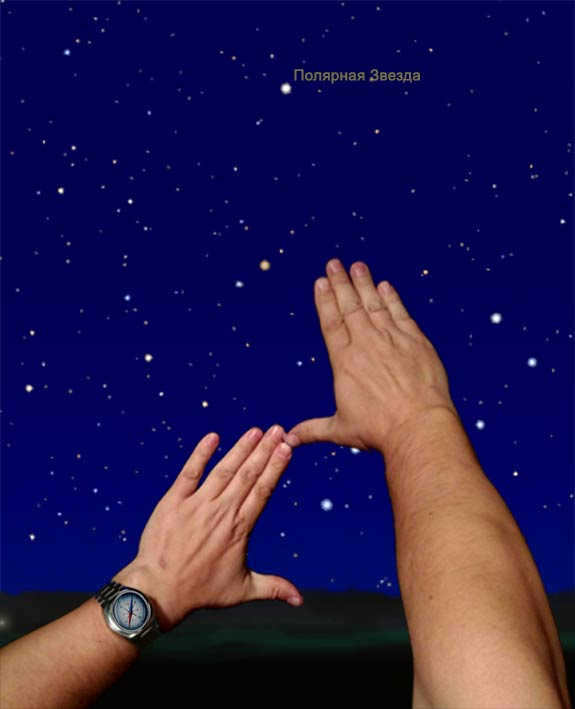 Fig. 7 Estimating the angular altitude of Polaris using outstretched arms – view of the starry sky at the latitude of Moscow.
Fig. 7 Estimating the angular altitude of Polaris using outstretched arms – view of the starry sky at the latitude of Moscow.
